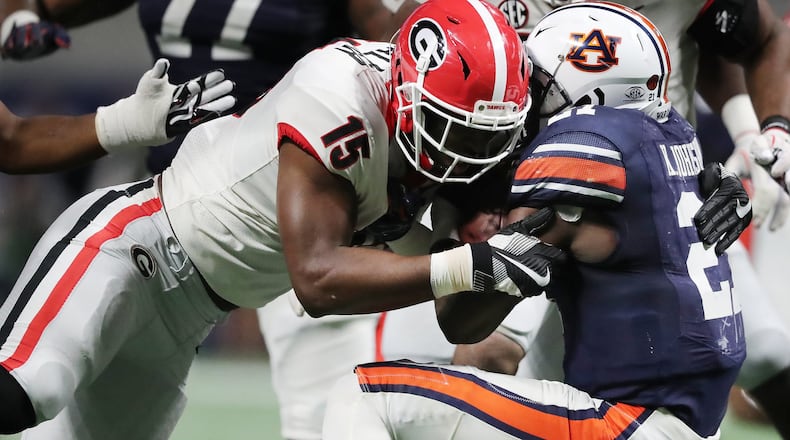Despite the risks of head injuries, the University of Georgia and many top-tier athletic programs still fail to systematically track by sport the concussions their athletes sustain, an Atlanta Journal-Constitution survey of 62 programs found.
The AJC’s analysis of NCAA Division I, II and III schools found that about 1 in 6 athletic programs do not count student-athlete concussions by sport, even though such data collection could lead to better safety protocols for their athletes.
The NCAA has run a program to report and track concussions and all other student athlete injuries for research purposes since 1982 — but there is no requirement that member schools report to it.
Concussion data is easy to collect and may hold crucial clues on how to prevent concussions and their worst impacts, or help athletic trainers spot trends. NCAA schools record athlete injuries in their personal medical records, which nowadays are stored electronically. These systems can make tallying any type of injury as simple as pushing a few buttons, researchers and college athletic trainers said.
"There is absolutely no reason why all concussions — and in fact, all collegiate sports injuries — should not be mandated as NCAA-reportable conditions," said Steve Marshall, director of the University of North Carolina's Injury Prevention Research Center. He and other epidemiologists at his center have studied college athlete concussions extensively.
To this day, P.K. Sam has no idea how many concussions he sustained over his football career, which began in metro Atlanta and ended in the NFL.
Sam, an All-State football star who played both offense and defense at Buford High, remembers going home from games with bruises on his head or a black eye from when his helmet hit his face after a bad hit to the head. Later, at Florida State, a crushing hit knocked him out during a game with the University of Miami, but he kept on playing.
“It happens so much you just don’t know, especially in college,” said Sam. “Everybody is trying so hard to get into the NFL.”
Sam wishes that his teams kept better tabs of his concussions, which he believes has led to bouts of rage, seizures, memory loss, dizziness, debilitating headaches and extreme sensitivity to light.
“I do wish they kept better track, so at least you were informed,” he said.
Funding for tracking concussions should be easy, experts said. The Power 5, college football's biggest and most lucrative conferences, could easily foot the bill for NCAA schools that cannot afford necessary personnel and equipment, Marshall said. The University of Georgia and Georgia Tech belong to Power 5 conferences.
“The infrastructure to do this is already in place … it’s just a question of funding it, and the Power 5 have lots of money,” he said.
Much of what researchers know about the total number of concussions in collegiate sports, their severity, and who gets hurt are based on estimates, said Marshall. And since the schools that volunteer to send data to the NCAA are not randomly selected, it's unknown whether their data give a full picture of the problem.
UGA no longer compiles data
At the University of Georgia, the athletic department stopped tracking concussions after the 2011-2012 and 2012-2013 school years once it had completed a grant application to study of the injury, a spokesman said in a written statement. During those years, the 125-member football program had the highest number of concussions, but the cheerleading team, which is less than half its size, had higher rates, their numbers show.
“We no longer compile concussion data because we have not had a need to do so,” the statement said. A UGA spokesman did not provide additional information despite repeated requests.
Other athletic departments consider tracking to be essential.
The reigning Division I national football champion Clemson University has tracked its injuries for at least the past 20 years, using an electronic system for 15, said Clemson Associate Athletic Director Joe Galbraith. Spikes in any type of injury in any of the college’s sports programs could signal that coaches need to make changes.
“I think the biggest thing is the ability to spot any trends,” Galbraith, a department spokesman, said.
Georgia Tech has voluntarily reported its sports injury data to the NCAA for years, said Jay Shoop, Georgia Tech’s director of sports medicine and a 45-year veteran of athletic training.
"The more information we have, the more it can go to aid our student athletes," said Shoop, whose experience as an NFL athletic trainer with the Atlanta Falcons, Detroit Lions and Tampa Bay Buccaneers taught him that scientists need all the data they can get to study the long term impact of concussions.
“I got a lot of guys my age, a lot of them are perfectly fine,” Shoop said. “I know some that are not, unfortunately.
“Why is that?”
NCAA funding research
To NCAA leaders, what's more important is that the organization fund quality, scientific research that can help them improve their practices, said Brian Hainlinen, a neurologist and chief medical officer of the NCAA who oversees its Sport Science Institute.
The NCAA is working with the U.S. Department of Defense on a 30-school, multimillion-dollar study to fill key gaps in concussion research, such as the impacts on women and risks of repeated injury. About 90 percent of athletes at participating universities have opted to participate, Hainlinen said, including UGA.
“We don’t need 100 percent participation to get a representative sample of how concussions are happening. We need a fair sample. The rigors of scientific analysis should apply,” Hainlinen said. What’s more, tracking concussions is easier said than done.
“We don’t have any objective definition of concussion yet,” Hainlinen said. “I think this study is going to provide us with key, common data elements to collect.”
The study already has changed the way the NCAA plays football. This year, the NCAA elected to follow an NFL ban on two-a-day practices in football pre-season after finding that concussions most often occurred in August on days where two contact practices took place in the same day.
Current NCAA concussion protocols require that coaches remove from play student-athletes who show concussion symptoms and have them evaluated by experienced medical staff. Those diagnosed with a concussion cannot return for at least the rest of the day, and must be cleared by a physician or his or her designee. All players also receive education on concussions.
Tracking can reduce injuries
Data on any injury can change how the game is played. At the University of Kansas, data helped athletic trainers lower the number of hamstring strains and other soft tissue injuries during football training camp by about 3 percent, said Director of Sports Medicine Murphy Grant. Grant, who is executive chair of the National Athletic Trainers’ Association’s Intercollegiate Council for Sports Medicine, said that increasing the intensity of late July workouts helped coaches keep athletes healthier as they compete for playing time during pre-season training.
Grant creates a daily tracking calendar for his athletes that notes the temperature, the type of field, the number of athletes and other conditions so he can spot problems as they arise, he said.
“Once you can pull the data, you can decipher it to see what we can do to decrease the number of injuries,” Grant said.
But even sports programs that track and monitor injuries extensively meet roadblocks. The University of Kansas does not participate in the NCAA’s tracking system because it uses different software and needs to set up protocols to share data without compromising patient privacy, Grant said.
Even if tracking of concussions and other sports injuries were mandatory, some athletic trainers wonder if all the knowledge they gained would be put in practice. Most college programs aren’t awash in cash and many budget too little for athlete health, said Arnold Gamber, the University of West Florida’s head athletic trainer.
Salaries for athletic trainers are only a fraction of what coaches receive, Gamber said. Smaller schools may only have funds to hire one to cover 60 students.
“I see these mandates come down every year, and if they’re not giving any more money or more staffing to get things done, it’s not going to get done,” said Gamber.
Explosions of rage
It took years for Sam to realize that his playing days left him with long-term neurological problems. Sam grew more aggressive as he moved on from Buford High to become a standout wide receiver at FSU, but his parents thought the mood changes were just a part of growing up, he said.
The New England Patriots chose Sam as a fifth-round draft pick in 2004 and he won a Super Bowl XXXIX ring with the team the next year.
In 2008, after he blacked out and collapsed while alone in his apartment, Buffalo Bills medical staff told him he was dehydrated, Sam said. When he collapsed a second time about two years later, he and his wife worried he had a heart attack. That’s when doctors told him that he was experiencing seizures caused by head trauma.
“You can feel yourself shaking, trying to get up but you can’t. It was like you were there, but not really there,” Sam said.
NFL doctors said his college days were to blame for his symptoms, a conclusion Sam had no way of challenging because no one had ever kept track of his injuries.
It’s unlikely he’ll receive money from the professional league’s concussion settlement, he said.
Sam is completing his college degree at Florida State. He doesn’t currently have a neurologist. He shuts himself in a dark room when he feels an attack coming on.
It begins with dizziness and a piercing headache. It’s followed by explosions of rage.
“I’m not going to receive money from the NFL, but I’m just as damaged,” Sam said.
AJC Data Reporting Intern Stephanie Lamm and Data Specialist Jeff Ernsthausen contributed to this report.
How we got the story
Under the Georgia Open Records Act, The Atlanta Journal-Constitution asked every public college and university in Georgia with an NCAA Division I, II or III football program to provide totals they had collected of student-athlete concussions by sport for at least the five previous years.
The AJC also asked each school to turn over copies of its policies concerning how student-athlete concussions are handled and treated.
As the football programs across the state range from very large to very small, the newspaper sought a means of comparing each school to others its own size. To do that, the AJC identified the athletic conference to which each Georgia school belonged, and then sent requests to the competitor schools in those conferences. Requests made to the out-of-state schools were made citing the freedom of information laws of that state.
In all, the newspaper sent requests to 62 public and semi-private colleges and universities in 16 states. The schools belonged to seven athletic conferences: Southeastern, Atlantic Coast, Sun Belt, Atlantic Sun, South Intercollegiate, Gulf South and Mid-Eastern Athletic. Private schools were excluded because they are not legally obligated to disclose information.
Several schools did not provide access to the AJC’s requests. Five declined, saying their data was exempt from their state’s public information laws. Eight schools did not respond. A half-dozen acknowledged receipt of the request but then never turned over the requested information. A few schools provided data but turned over less than the requested five years without explanation.
Twenty schools provided data on concussions for their football programs. The AJC entered that information into a database to analyze the statistics for this story. To see more about that data, see this related story.
Keep Reading
The Latest
Featured








